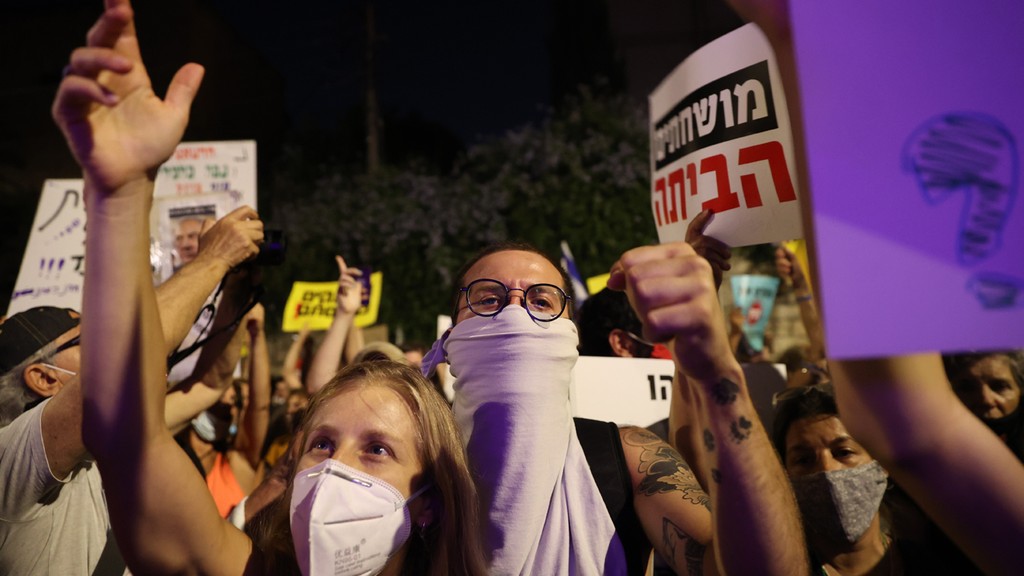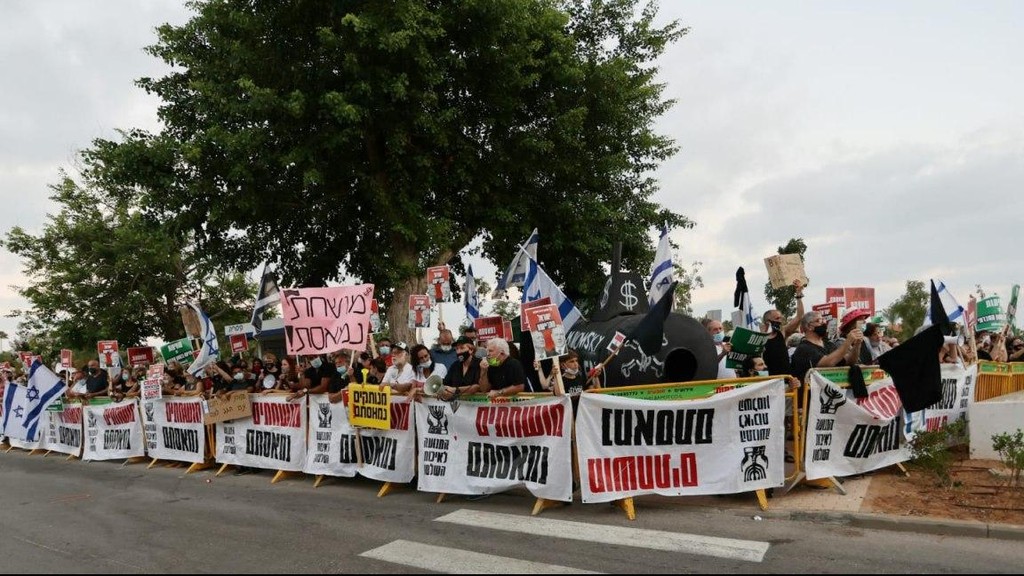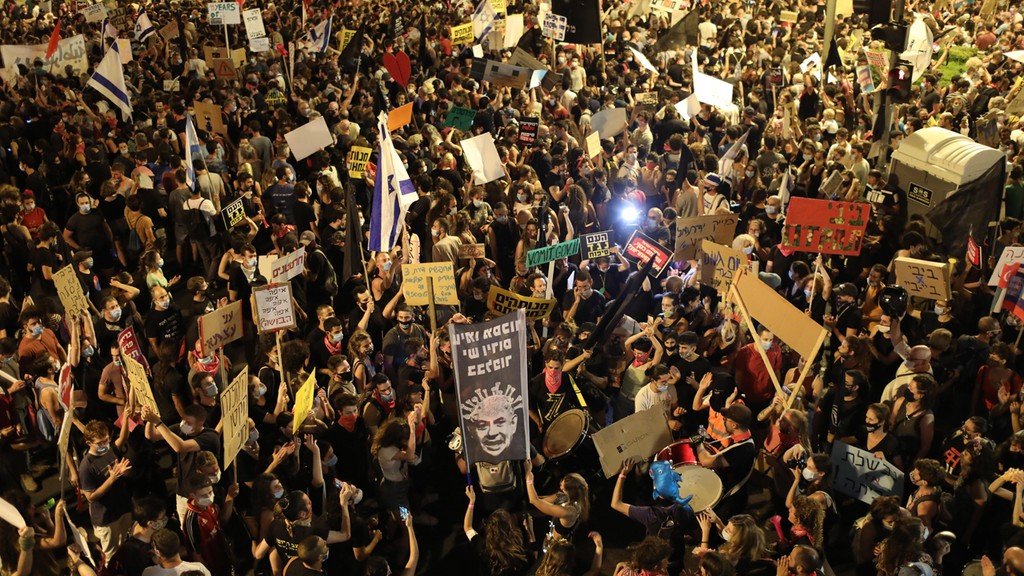Getting your Trinity Audio player ready...
On a sweltering summer day, the need for shade and liquid refreshment seemed to provide common ground for opposing camps around the corner from Prime Minister Benjamin Netanyahu’s official residence on Jerusalem’s Balfour Street, and for the police keeping them apart.
The scene on Sunday afternoon was calm – at least compared to the night before when thousands had noisily demanded Netanyahu’s resignation and an end to government corruption, and others almost as noisily expressed support for the embattled prime minister.
5 View gallery


Protesters call for the ouster of Benjamin Netanyahu outside his residence in Jerusalem
(Photo: Yoav Yoav Dudkiewicz)
Despite the day’s tranquility, however, the messages remained distinctly different.
“We support Benjamin Netanyahu and… we’re here to say that in Israel, the prime minister is elected. We say kalpi, not hafganot,” says Jerusalemite Iris, who asked that her last name not be used, using the Hebrew words for voting booth and demonstrations.
She was sitting with seven other Netanyahu supporters on garden chairs set up on the sidewalk near the official residence.
A few steps away, on similar chairs at the anti-Netanyahu camp, were 14 people, among them Mitchell Akawie.
Akawie, 18, who moved to Israel four years ago from the Washington, D.C., area, said that their goal was to get the prime minister to leave office.
“That’s the ultimate hope and desire,” he says, turning his message directly to the prime minister.
“Really and truly,” the anti-Netanyahu protester says, “we want to say that it is time for you to go. You have got to do this on your own.”
Of the 5,000 protesters who gathered on the scene the evening before, 12 were arrested, police said.
5 View gallery


Protesters call for the PM to resign in a demonstration in Jerusalem
(Photo: Alex Kolomoisky)
The demonstrations have been going on for the past few weeks, concentrated mostly outside the official residence, but also in Tel Aviv’s Rabin Square outside City Hall and more recently outside the home of Public Security Minister Amir Ohana in the city. However, they have since spread to other parts of the country, often along highways and on overpasses.
In a first, hundreds gathered on last week outside Netanyahu’s private home in the swank seaside town of Caesarea, having requested and been issued a permit by police – who were thus able to fence off the residence and block off streets before the demonstrators arrived.
In order for the protest movement to continue to gain supporters and affect real change, organizers must focus on a single message and broaden the scope beyond ousting Netanyahu, says Carmit Padan, a research fellow at the Institute for National Security Studies at Tel Aviv University.
“The [cost of living] protests of 2011 had a very clear message. They said that the people want social justice. It was a very defined and clear message, and now we don’t really see a very clear message,” she says.
5 View gallery


Protesters call for Netanyahu to resign outside his home in Caesarea
(Photo: Gil Nachshon)
The initial protests against Netanyahu focused on emerging reports of police investigations into corruption, with demonstrators saying he should not continue to serve as prime minister with such allegations hanging over his head. The protests swelled with indictments, and finally the beginning of a trial in April.
But many more people began to turn out to protest the Netanyahu government’s handling of the coronavirus pandemic and the resulting economic collapse, with unemployment swelling within weeks from 4% to about 25%. Now, a new outbreak following what may have been too hasty a reopening, people are just as angry about policies as they are about perceived corruption.
Padan believes that while it is still too early to tell if the protest movement will have the power to sustain itself through sheer numbers, one sign that it might is the wide range of the participants’ ages.
“On the one hand, elderly people are protesting that Israeli society is throwing away its elderly in the name of the economy,” she says. “And on the other hand, many young people are leaving their houses, going into the streets and joining the protests.”
Asaf Agmon, 72, a retired Air Force brigadier general, began agitating for Netanyahu’s resignation close to three years ago when the allegations of corruption against Netanyahu were first reported.
5 View gallery


Protesting the arrest of anti-Netanyahu demonstrator Amir Haskel in Jerusalem
(Photo: Haim Golditch)
He demonstrated together with Amir Haskel, who served under him as a military pilot and eventually reached the same rank – and today is considered one of the protest leaders. The two began to sit around the corner from the prime minister’s official residence 47 days ago after deciding that they could draw more media attention there than in Tel Aviv.
“The crucial point is not Tel Aviv’s Rabin Square, with 100,000 people,” Agmon says. “The crucial point is Balfour Street, the symbol of government, the house of the prime minister.”
The public spaces near the residence are far smaller than Rabin Square in Tel Aviv, meaning that they are easier to fill and make for far better photos and footage.
“We believed that 5,000 people demonstrating [near] Balfour Street would make a difference,” he says. “Today I can say that we were right.”
Agmon believes a major change in the protests occurred two weeks ago, when young people, too, realized that Balfour Street was the right gathering place for the movement, and began swelling the demonstrators’ numbers.
He feels that older people like himself remember when the country seemed less corrupt. Young people, though, are now suffering from the way the government has handled the pandemic and are truly fired up.
5 View gallery


A Demonstration calling for Netanyahu's resignation outside his official residence in Jerusalem
(Photo: EPA)
“The young generation’s main slogan is ‘We have stopped working for you; now you have to work for us,’” Agmon says, referring to Netanyahu. “We voted for you to work for us. We didn’t vote for us to work for you.”
Article written by Joshua Robbin Marks. Reprinted with permission from The Media Line

